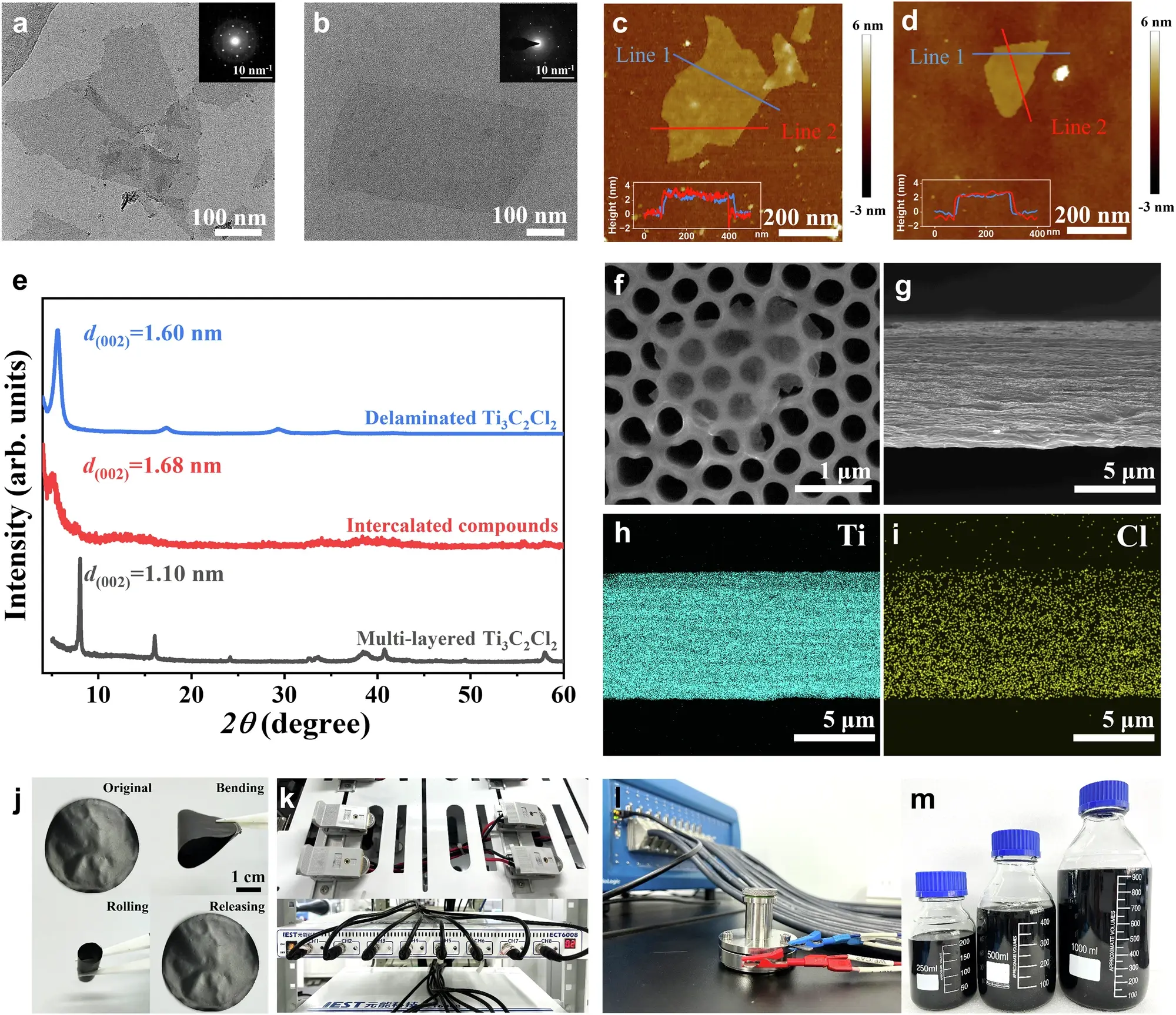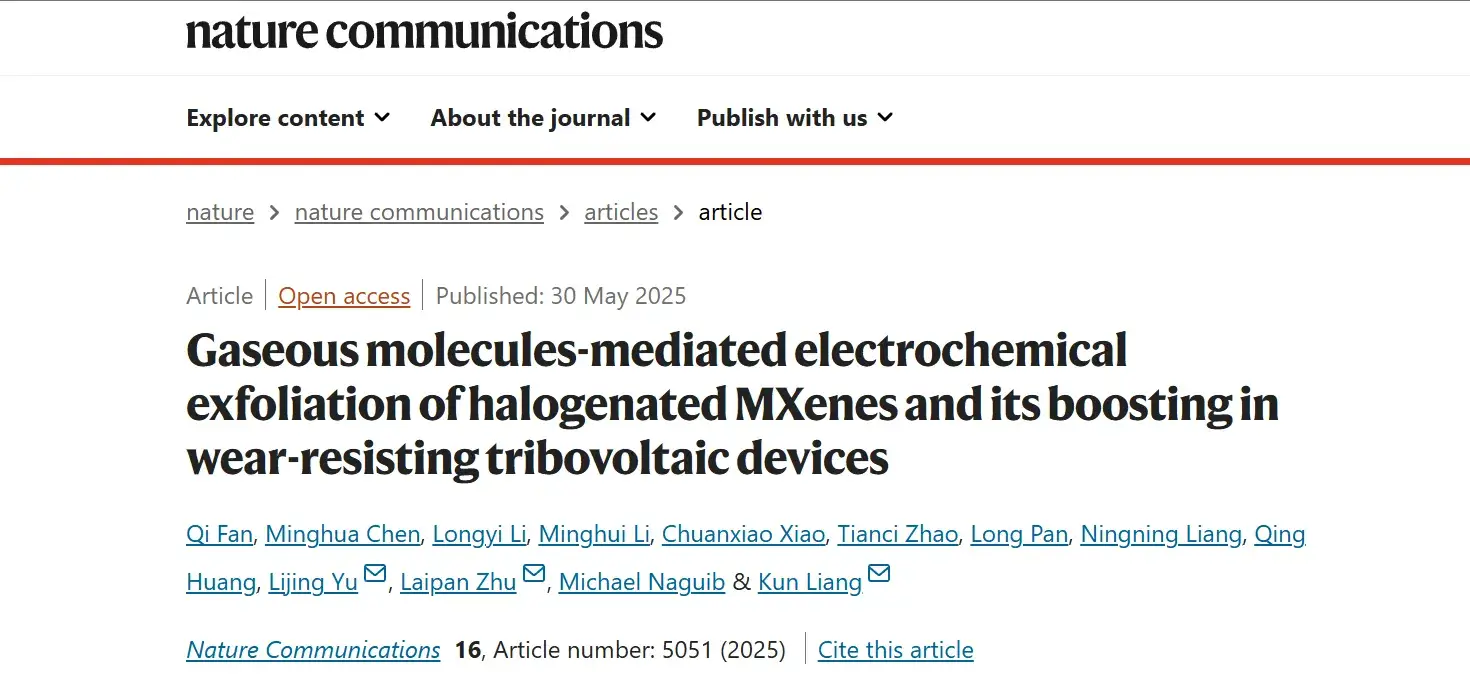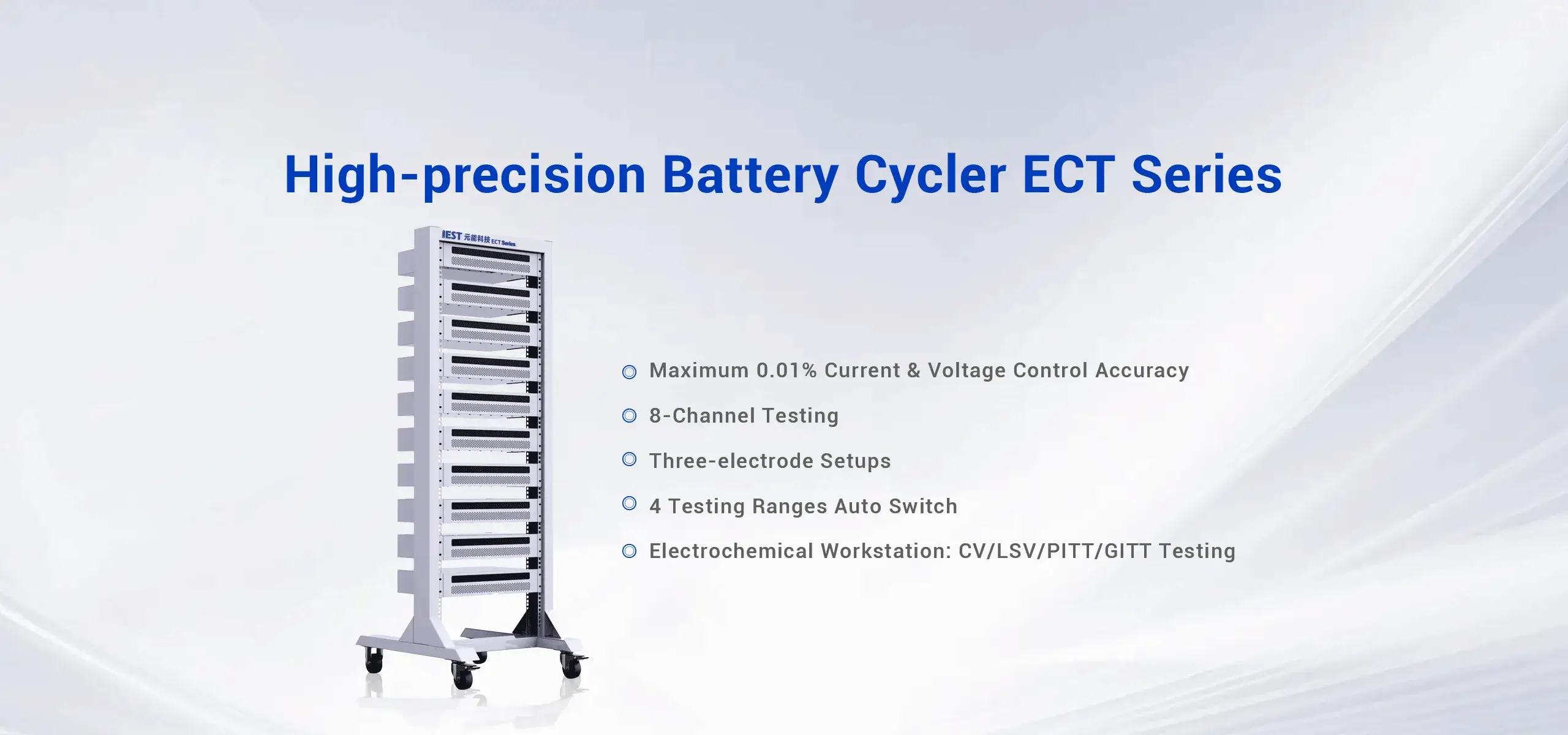-
iestinstrument
Gaseous Molecules-mediated Electrochemical Exfoliation of Halogenated MXenes and its Boosting in Wear-Resisting Tribovoltaic
1. Article Information:
-
First Authors: Qi Fan, Minghua Chen, Longyi Li
-
Corresponding Authors: Kun Liang, Laipan Zhu, Lijing Yu*
-
Affiliations: Ningbo Institute of Materials Technology and Engineering (NIMTE), Chinese Academy of Sciences; Beijing Institute of Nanoenergy and Nanosystems; Xihua University
-
Equipment Used: IEST ECT6008 Constant Current Charge/Discharge Battery Cycler
2. Research Background
Two-dimensional transition metal carbides/nitrides (MXenes), particularly few-layer nanosheets, have emerged as a forefront research area in advanced materials due to their exceptional electrical conductivity, rich active surfaces, and tunable processability. Molten salt etching enables the synthesis of MXenes terminated with -Cl, -Br, -I, -S, -Se, or -Te groups, allowing precise control over surface chemistry and intrinsic properties. However, the low yield of few-layer MXenes produced by this method limits their practical applications.
3. Work Summary
Recently, a team led by Prof. Kun Liang at NIMTE, in collaboration with Prof. Laipan Zhu at Beijing Institute of Nanoenergy and Nanosystems and Prof. Lijing Yu at Xihua University, proposed a novel strategy for efficient electrochemical exfoliation. This method precisely regulates the solvation environment of Li⁺ ions in the electrolyte. During the electrochemical process, Li(PC)~n~⁺ complexes (where PC = propylene carbonate) intercalate into the interlayer spaces of multilayer MXenes. Subsequent electrochemical potential control triggers the in-situ decomposition of these solvated ions, generating gaseous propylene (C₃H₆) molecules. These gas molecules act as “physical scissors,” effectively weakening the strong interlayer binding forces in halogen-terminated MXenes, thereby enabling the highly efficient exfoliation of few-layer MXenes with -Cl/-Br terminations. Under optimized cut-off voltage conditions, this process achieves a remarkable yield of 93%. The exfoliation is mild and preserves the surface chemical characteristics of the nanosheets intact. Further investigation revealed that the resultant few-layer MXenes, when used as lubricants in Tribovoltaic Nanogenerators (TVNGs), significantly enhance device performance. Notably, Ti₃C₂Br₂ substantially boosts the electrical output signals. This electrochemical exfoliation strategy not only deepens the understanding of MXenes’ intrinsic properties but also provides a new avenue for the nanoengineering design and functional expansion of other two-dimensional layered materials (Fig. 1).

Figure 1. Schematic illustration of the gaseous molecule-mediated electrochemical exfoliation of halogen-terminated MXenes and their enhancement effect in wear-resistant tribovoltaic devices.
4. Key Findings
Building upon the “chemical scissors-assisted structural editing strategy” (H. Ding, et al. Science 2023, 379, 1130), this work introduces a “physical scissors-assisted electrochemical exfoliation strategy,” achieving a high degree of customization in the surface chemistry and electronic structure of few-layer MXenes. The mild and efficient exfoliation process ensures the stability of the MXenes’ crystal structure and surface chemistry while significantly increasing both the yield and quantity of obtained few-layer MXene nanosheets (Fig. 2).

Figure 2. (a-j) Structural and morphological characterization of few-layer halogen-terminated MXene nanosheets; (k-l) Electrochemical exfoliation setup; (k) The electrochemical intercalation process was performed using the IEST ECT6008 Constant Current Charge/Discharge Battery Cycler; (m) High-yield dispersion of exfoliated few-layer MXenes.
Through combined characterization techniques including in-situ X-ray diffraction (XRD), in-situ electrochemical differential mass spectrometry (DEMS), quasi-in-situ Fourier-transform infrared spectroscopy (FTIR), and scanning electron microscopy (SEM), the research team elucidated the three-stage mechanism of “intercalation-expansion-delamination” during the electrochemical exfoliation of MXenes. This provides a generalized technical paradigm for the efficient exfoliation of two-dimensional materials with strong interlayer binding forces. Benefiting from the mild exfoliation process, the prepared high-yield few-layer MXene nanosheets exhibit highly tunable key physical properties, including work function, electrical conductivity, surface wettability, and optical transmittance. Utilizing few-layer halogen-terminated MXenes as interfacial lubricants, their high contact angle effectively enhances the triboelectric effect at the solid-liquid interface, significantly improving the electrical output signal and cycling lifetime of Tribovoltaic Nanogenerators (TVNGs) (Fig. 3). Crucially, this method demonstrates broad applicability, successfully enabling the efficient exfoliation of other van der Waals layered materials such as TiS₂, TaS₂, and CrSe₂, highlighting the versatility and extensive application potential of this exfoliation technique.

Figure 3. Effect of MXene lubricants with different terminations on the output performance of the tribovoltaic nanogenerator.
5. Conclusion
This research pioneers an efficient electrochemical exfoliation method, utilizing gaseous propylene molecules to achieve high-yield production of few-layer halogen-terminated MXenes. The results underscore the importance of the electrochemically modulated “intercalation-expansion-exfoliation” mechanism. Given the significant influence of surface group modification on the electronic and surface properties of MXenes, the obtained Ti₃C₂Br₂ dispersion serves as an effective interfacial lubricant, contributing to the realization of high-performance tribovoltaic devices. The scalability and adaptability of this method open new pathways for the industrial application of two-dimensional nanomaterials, setting a new benchmark in materials science and reflecting the immense potential of MXenes in meeting global demands for sustainable and high-performance energy solutions.
6. Original Article
Qi Fan, Minghua Chenˣ, Longyi Li, Minghui Li, Chuanxiao Xiao, Tianci Zhao, Long Pan, Ningning Liang, Qing Huang, Lijing Yu*, Laipan Zhu*, Michael Naguib, Kun Liang*. Gaseous Molecules-mediated Electrochemical Exfoliation of Halogenated MXenes and its Boosting in Wear-Resisting Tribovoltaic Devices. Nature Communications, 2025, 16, 5051.
7. Related Testing Instrument Recommendation
Features:
- Provides accurate benchmark data for lifespan prediction, inventory efficiency, self-discharge, and micro-reaction testing, with voltage and current precision of 0.01%.
- Supports a wide range of cell types, capacitor materials, half-cell, three-electrode, coin cell, and small-capacity testing.
- Triple protection (software, hardware, firmware) ensures safe operation for both equipment and samples.
- Supports electrochemical testing methods: GITT, PITT, CA, and CP
- Flexible auxiliary channel integration for temperature control, surface temperature monitoring, three-electrode setups, and pressure detection.
- Online calibration and independent operation of channels without interference.
- Private cloud platform and cloud server backup ensure data security and confidentiality.
Contact Us
If you are interested in our products and want to know more details, please leave a message here, we will reply you as soon as we can.




